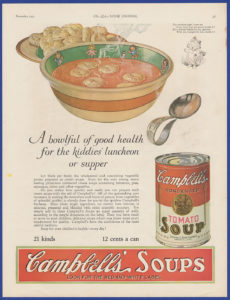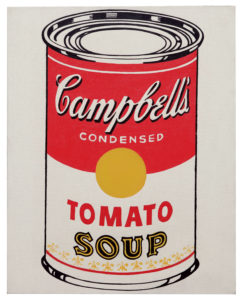
I grew up in a two-income household long before it was fashionable. My father owned a truck garage in Miami, Oklahoma, and my mom was a first-grade teacher. That meant times were busy around my house, and a kid frequently was expected to fend for himself, lunch-wise.
No problem. The good folks at Campbell’s Soup took care of that. A good-faith estimate is that I have eaten 3,744 cans of Campbell’s Soup over the years. That’s averaging about a can and a half per week. If anything, that figure is low. In fact, in my cubicle at work, I have four cans of Chunky stashed away (along with fat-free saltines, of course, more on that later) for those days when I really don’t want to go out and blow ten bucks on lunch.
Making Campbell’s vegetable soup (my childhood favorite, LOVED those alphabet characters!) was a snap for a seven-year-old. Just open the can, mix up a can of water, and heat until just hot enough. Mmm, mmm, good!
Campbell’s Soup got its start back in 1894. A man named John Dorrance was hired by his uncle, the company president (then Anderson & Campbell Preserve Company), for a salary of $7.50 a week. While that may have been good pay for a laborer, Dorrance had a chemistry degree from MIT and a Ph.D. from the University of Gottengen in Germany. But he took the meager wages in order to work for his uncle.
It turned out to be a very good move for the Campbell’s company.
Canned soup was very popular in Europe, as the younger Dorrance was aware. And it was inexpensive to manufacture. However, it was mostly water, and therefore expensive to ship. So Dorrance set to work to see about removing some of that weight. He eventually developed a technique to remove half of the water, lightening the canned soup’s weight considerable, and making its preparation a simple matter of pouring the can into a pan and adding one more can of water.
Suddenly, sales of soup to Americans was feasible. And as Campbell’s began marketing it, sales skyrocketed. At ten cents a can, consumers loved it. By 1922 Campbell’s added the word “Soup” to their name. And hopefully, Dorrance received lots of very nice raises.
So kids of many generations grew up with the tasty stuff. By the Jet Age, parents on the go loved quick, easy lunches that their kids willingly devoured. And tons of TV and magazine advertising ensured that every cupboard in America was supplied with a generous amount of Campbell’s Vegetable, Chicken Noodle, and Tomato Soups. At least ours was.

Pop artist extraordinaire Andy Warhol saw that Campbell’s Soup had become a part of American culture, so he began producing paintings that incorporated it. And they, like campbell’s Soup itself, were also huge sellers.
Campbell’s Soup was simply something that I never got tired of. As I grew older, I learned to spice it up a bit. A little hot sauce goes a long way towards waking up subtle flavors in chicken noodle and tomato soup. And a pinch of curry powder is great in the chicken noodle variety as well.
Then there are the crackers. I’m a cracker smasher, I’m a bit abashed to say. My idea of a perfect serving of Campbell’s Vegetable Beef is to heat it to near boiling, then pour it in a bowl big enough for the entire amount (or simply eat it out of the pot if I’m sitting in front of my home computer) and crush an entire sleeve of fat-free Premium Saltines into the hot mixture, then stir to form a cracker/soup colloid, of sorts.
Strange, I know, but you know what? It’s mmm, mmm, good!